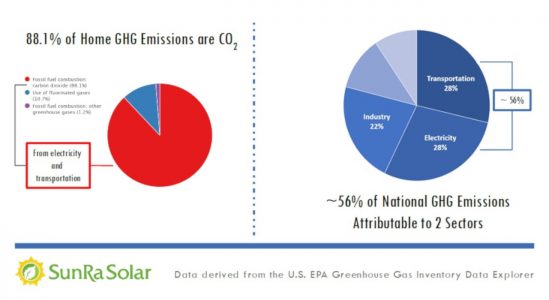Solar News & Information
Solar Energy and Electric Vehicles Are
the Fast Track to a Low Carbon Lifestyle
March 12, 2019
According to the U.S. Environmental Protection Agency (EPA), the nations’ transportation and electricity sectors account for over half (approximately 57%) of the total greenhouse gas emissions (GHG). Interestingly, the EPA analysis concludes they are essentially equal contributors, at nearly 28% of the total for each sector. Industry and the manufacturing of goods is the third most significant contributor.
When considering the typical home, the EPA reports as much as 88% of the GHG emissions are tied to fossil fuel related electricity and transportation. Driving and powering the home represent the majority of a household’s impact.
Choices to Reduce Household GHG
Making wise and educated routine consumption choices with carbon emissions in mind is the easiest and perhaps fastest way to lower one’s impact on GHG emissions. The fast moving trend to reduce plastic bag usage is one example.
Because so much GHG result from direct energy use, the greatest and most enduring positive environmental impact will come changing electricity sources and transportation sources.
Simply buying an EV may not give provide enough change in emissions. Some states and regions power the grid with high levels of coal and natural gas. Others rely to a greater degree on nuclear in the fossil fuel mix. Still, others enjoy a high degree of clean energy including hydropower and wind and solar energy. And many non-urban families require greater mobility where often two or more cars are in near daily use.
Massachusetts relies heavily on an increasing amount of natural gas generation on top of the booming solar power market. Offshore wind is off to a strong start, as well, however it will take a few years to reach a reasonable capacity.
Savings and Emissions Reduction
A solar energy system will save thousands of dollars over the lifetime of the system.
A typical electric vehicle is cheaper to operate and maintain than a gasoline powered car for every 12,000 miles traveled.
Both can drastically reduce the carbon emissions of their owners.
Massachusetts Solar Energy and EV Programs
For Solar Energy
For Electric Vehicles
The Bay State has made reasonable progress in electrifying personal transportation. Thanks to the MOR-EV program, by the end of 2018 over 12,000 pure electric and plug-in hybrid electric vehicles are now traveling the streets. Because of this success, the state transitioned the program for 2019 to cover only pure EV purchases. Visit the Massachusetts Department of Energy Resources MOR-EV website for current incentive details.
Solar Energy and Electric Vehicles Working Together
Although charging an EV directly from a solar energy source is not practical, it is still possible to in effect charge using clean energy. The rooftop solar energy system must be adequately designed to offset the net average electricity consumption for living and powering the home plus the anticipated EV charge demand.
Not only will this maximize the household’s GHG reduction, but it also provides the greatest long term savings. Most or all of the energy used over time will be generated by the solar energy system and offset through net metering against any power purchased from the utility.
SunRa Solar Making It Happen
Many homeowners may consider making a solar energy and an EV purchase at the same time, making the design process simple. SunRa Solar will gladly work with buyers to select and install a high capacity solar energy system as well as a suitable EV charging station.
Others may have already made their EV investment, and the design step to solarize the home is just as easy.
SunRa Solar also works with homeowners with future plans to invest in one or more EVs. By considering a near future EV addition during the solar design phase, the steps to include charging and ensure maximum energy savings are easier.
The average EV usage requires about as much electricity for charging as a hot water heater for a family of four. So, a solar installer can simply design the system to accommodate this. Buying an EV and adding an EV charger later becomes quick and easy. If needed, solar panels can be added at that time.
Contact Us with questions or to see exactly how solar power will work for YOUR home, saving you thousands. It’s a free evaluation with absolutely no obligation.


